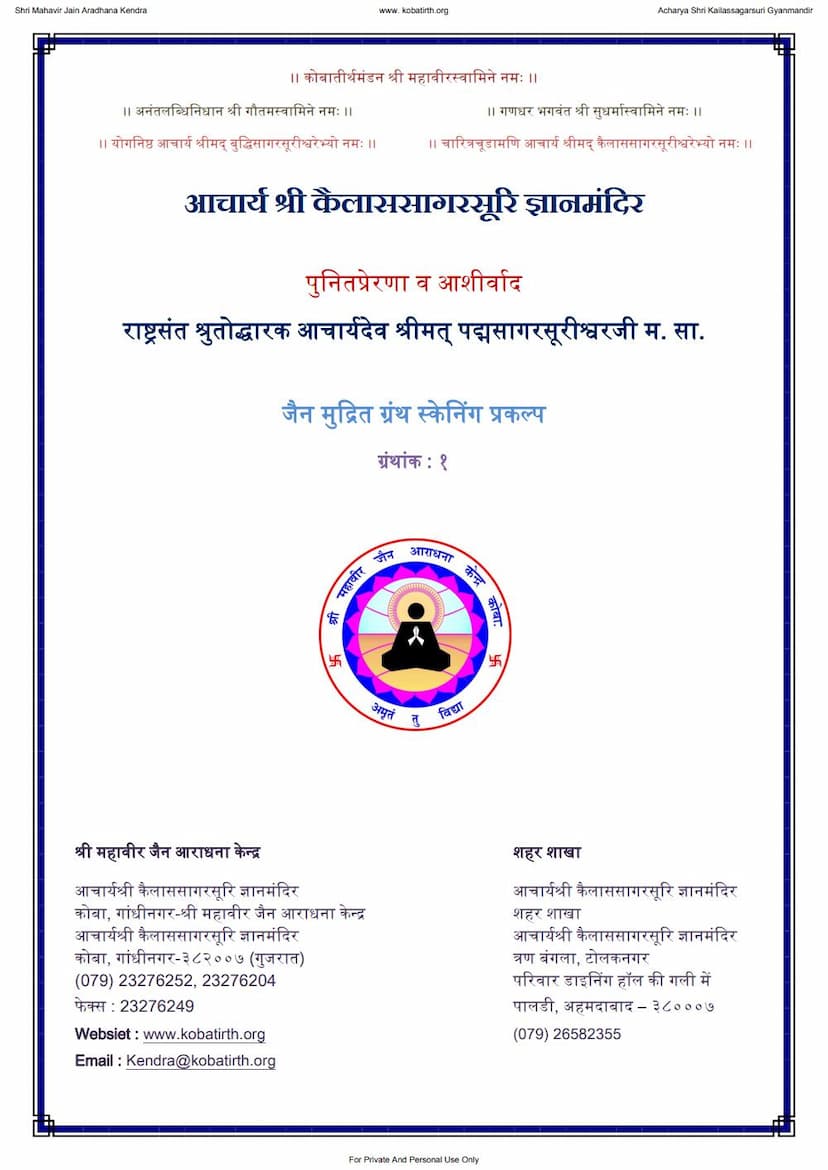Anuyogdwar Sutram Part 02
Added to library: September 1, 2025

Summary
The provided text is a substantial portion of the "Anuyogdwar Sutram Part 02," authored by Kanhaiyalal Maharaj and published by A B Shwetambar Sthanakwasi Jain Shastroddhar Samiti. The text is in Sanskrit and Hindi, with Gujarati translations and explanations. It is part of a larger Jain canon and focuses on detailed enumerations and classifications within Jain philosophy.
Here's a breakdown of the key themes and content based on the provided pages:
1. Introduction and Salutations:
- The text begins with salutations to revered figures in Jainism: Shri Gautam Swami, Acharya Shrimad Buddhisagarsurishwarji, Shri Mahavir Swami, and Ganadhar Bhagwant Shri Sudharmaswami, along with Acharya Shrimad Kailassagarsurishwarji.
- It mentions the "Shri Mahavir Jain Aradhana Kendra" and "Acharya Shri Kailassagarsuri Gyanmandir" as the institutions involved in the project, highlighting their web presence and contact information.
- The text is presented as the second part of the "Anuyogdwar Sutram," enriched with the commentary "Prameyachandrika" by Jainacharya Shrividhyagyan and translated into Hindi and Gujarati by Muni Shri Kanhaiyalalji Maharaj.
2. Core Content - Anuyogdwar Sutram (Part 02): The Anuyogdwar Sutram itself is a foundational text in Jainism that deals with the systematic exposition of Jain doctrines. The provided pages specifically delve into:
-
Enumeration of Rases (Emotions/Essences): The text begins by classifying and describing various "rasas" or aesthetic sentiments as per Jain tradition. Pages 17-25 cover:
- Bibhatsa Ras (Disgusting Emotion): Described as arising from contact with impurity, corpses, foul smells, and leading to detachment and non-violence.
- Hasya Ras (Humorous Emotion): Defined as stemming from imitation, contrast, and inappropriate representation of form, age, attire, or speech, leading to joy and cheerfulness.
- Karuna Ras (Pathos/Sadness): Characterized by separation from loved ones, loss, suffering, and distress, resulting in sorrow and lamentation.
- Shanta Ras (Peaceful Emotion): Attributed to a pure, calm, and serene mind, free from agitation and leading to renunciation of worldly attachments and attainment of spiritual peace.
-
Classification of Names (Namas): A significant portion of the text focuses on the classification of "namas" (names) and how they are derived or categorized. This is a complex topic within Jain philosophy dealing with how entities are named and conceptualized. The text outlines various categories of names, including:
- Gauṇa (Secondary/Attributive Names): Names derived from qualities or actions (e.g., 'kṣamaṇa' from 'kṣamate' - one who tolerates).
- Nai-gauṇa (Non-attributive Names): Names that don't directly relate to qualities or actions, possibly conventional or arbitrary.
- Ādānapada (Names from the beginning word): Names derived from the first word or phrase of a scripture or text.
- Pratipakṣapada (Names from contrasting terms): Names derived from opposing concepts.
- Pradhānyatā (Names based on prominence): Names derived from the most significant aspect.
- Anādisiddhānta (Names from eternal principles): Names originating from fundamental, timeless Jain principles.
- Avayava (Names from parts): Names derived from constituent parts of something.
- Saṃyoga (Names from combination): Names arising from the combination of entities.
- Pramāṇa (Names from measures/proofs): Names related to valid knowledge or measurement.
-
Detailed Explanation of Types of Names: The text provides extensive examples and explanations for each of these name categories, drawing from various Jain scriptures and concepts. This includes intricate linguistic and philosophical analysis.
-
Pramāṇa (Means of Valid Knowledge): The text categorizes "pramāṇa" (means of knowledge) into four types:
- Nāmapramāṇa (Name-based proof/measure): Knowledge derived from names.
- Sthāpanāpramāṇa (Installation-based proof/measure): Knowledge based on symbolic representation or installation.
- Dravyaprāmaṇa (Substance-based proof/measure): Knowledge related to the substance or reality of things.
- Bhāva-pramāṇa (Mental/Emotional state-based proof/measure): Knowledge related to the mental or emotional state.
-
Detailed Exposition of Pramāṇa: Similar to names, the text elaborates on each type of pramāṇa with examples, likely covering concepts like inference, perception, and scriptural authority.
-
Ayus (Lifespan) and Body Structures: Later sections (e.g., pages 154-248 and onward) discuss the lifespan and body structures (avagahana) of various beings, including:
- Narakas (hell-dwellers) across different hellish realms.
- Tiryagyonis (transmigratory beings) like Pṛthivīkāyas (earth-bodied beings), Apkāyikas (water-bodied beings), Tejas-kāyikas (fire-bodied beings), Vāyu-kāyikas (air-bodied beings), Vanaspati-kāyikas (plant-bodied beings), and beings with two, three, four, and five senses.
- Men (humans).
- Devas (celestial beings) in various heavens (Bhavanpatis, Vyantaras, Jyotishkas, Vaimānikas).
-
The Batviya Family: A significant portion of the text (pages 8-11) is dedicated to the biography of the Batviya family, specifically highlighting their deep religious devotion and contributions. It details the life of Shri Girdharbhai, his son Shri Amichandbhai, and their family's adherence to Jain principles, including the renunciation of family life by a daughter, Indumati. This section underscores the publisher's connection to and support for Jain scripture propagation.
3. Publisher and Project:
- The publication is part of the "Shri Akhil Bharat S. S. Jain Shastroddhara Samiti" (All India Svetambar Sthanakwasi Jain Scripture Restoration Committee).
- The scanning project is supported by the "Shri Mahavir Jain Aradhana Kendra" and "Acharya Shri Kailassagarsuri Gyanmandir."
- The first edition was published in Vikram Samvat 2024 (1968 CE) with 1200 copies.
Overall Summary:
The provided text is the second volume of the "Anuyogdwar Sutram," a detailed Jain treatise. It meticulously elaborates on philosophical concepts like rasas (emotions) and nāmas (names), and critically, it delves into the extensive classifications and measurements of time, space, and lifespan across different categories of beings in the Jain cosmology. This includes the physical dimensions (avagahana) and lifespans (sthiti) of beings in the hellish realms, the different elemental kingdoms (earth, water, fire, air, plants), and celestial beings in the heavens. The text also includes a biographical sketch of the Batviya family, indicating their patronage of this Jain literary project. The work is characterized by its scholarly approach, incorporating Sanskrit and Prakrit terminology with detailed Hindi and Gujarati explanations, aiming for a comprehensive understanding of Jain philosophy.